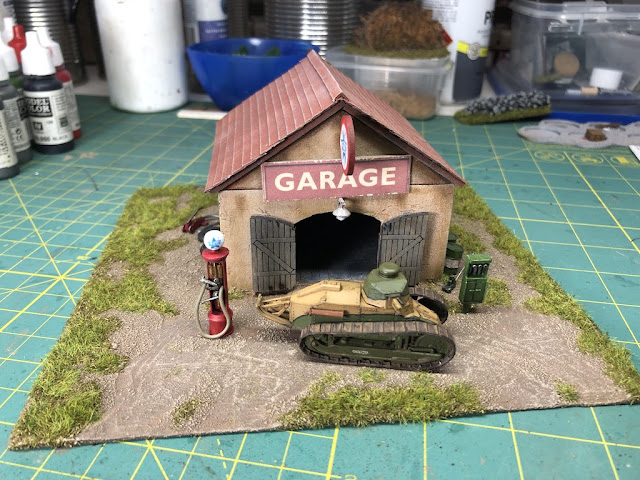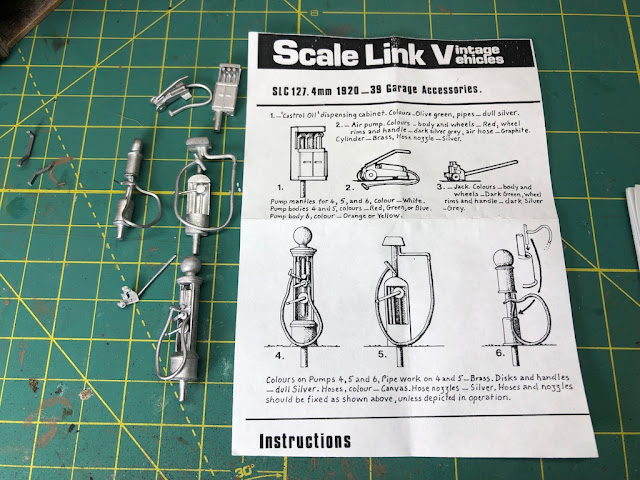I bought the Charlie Foxtrot Models 1/72 Workshop a few years ago and added little extra detail to it other than to texture the exterior before painting. It had come in useful as either a rural farm shed or an industrial building, however, much like my earlier Greenhouse it had always looked like it could do with some embellishment to bring it to life.
The basic building is up to Charlie Foxtrot's usual standards, but is essentially a simple MDF structure.
After texturing and a paint job I felt mine was perfectly presentable, however while the texturing had hidden the connecting plugs on the corners, I hadn't done anything about the visible attachment plugs in the roof tiles - always the tell tale sign of an MDF building.
It had seen action in a few games, but one thing I've noticed about writing a blog is I see a lot more images of my tables than I would normally otherwise do and so I tend to notice all the small things that could be improved.
I had been inspired by the marvellous French garage that Nick Skinner from Too Fat Lardies had created using the 28mm version of this same building. Given I'm working on terrain with a forthcoming France 1940 campaign in mind I thought I'd take a leaf out of Nick's book and build my own version.
 |
| Nick Skinner's inspirational garage |
First I needed to address the roof tiles and so I applied some of Charlie Foxtrot's laser cut tile sheets to give the roof a makeover.
While the roof tiles would need painting I was quite happy with the existing paint job on the walls and doors and so the next step was to find suitable signs. I had downloaded a selection of images a few years ago and amongst these were a range of very suitable commercial signs and advertising posters.
I mounted the Azur petrol sign on a 20mm round MDF base and planned to have this protruding perpendicular from the building exterior. At the same time I gave the roof tiles a coat of grey primer. It was already starting to look like a very different building.
If you've been following the blog recently you would have seen the post about how I made a simple set of railway signals. That build was based around a conversion of a railway yard lamp and had involved removing the light from the top of the pole. Rather than discard the lamp I thought I could find a good use for it here.
With a bit more cutting I had just what I needed. All it required was a coat of paint to give it an aged and distressed look to match the building.
Most of my buildings have grey tiles on the roof, so I decided to give some variation with the garage and go with terracotta tiles. After a base coat the tiles were dry brushed to give them better definition and add a more aged appearance. The lamp was painted and then a rust mix using Vallejo Hull Red mixed with Black Grey was applied with a fine brush.
Next my thoughts went to how to recreate a suitable petrol bowser from the 1930s. While searching for images on the web I came across this marvellous set of accessories from a model rail supplier that could not have been more perfect.
They were beautifully sculpted and cast, and with a lick of paint came out really well. Just the items to make this look like a working garage. Suitably inspired I then began to hunt around for other additions such as tyres and wheels and these came from the spares box having once belonged to the venerable Airfix Opel Blitz truck.
The next job was to cut an MDF base and bevel the edges with my Dremel. I could then work out where best to position the petrol pump and other elements around the garage exterior.
I was then able to get a feel for how this was all going to come together.
The final terrain element was to flock the base.
Lastly I grabbed a couple of oil barrels from the spares box and gave them a paint in Castrol colours (taking care to copy the 1930s style font!).
With all the other accessories in place I was happy to call this finished.
All that was missing was a period vehicle:


















































